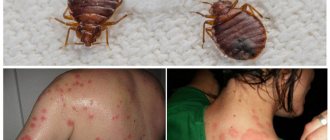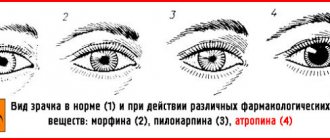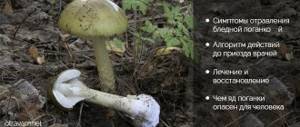Pale toadstool is considered the most poisonous mushroom in our area. Moreover, all its parts are dangerous. It is strictly not recommended to collect these mushrooms, since even with the slightest contact with the edible type, the poison of the toadstool is quickly absorbed into the caps and stems of a good mushroom. Outwardly, the toadstool does not cause any suspicion; it has a pleasant smell and taste. Often, instead of honey mushrooms, they bring poisonous toadstools, or they confuse it with other species. Therefore, you need to know the distinctive features to avoid poisoning and more serious consequences.
[edit] Causes of toadstool poisoning
The cause of poisoning is human consumption of collected fruiting bodies of the toadstool. It occurs by mistake or as a result of intentional poisoning.
In case of intentional poisoning:
- you can become a victim of the actions of another person or group of people;
- You can become poisoned as a result of your own actions.
Pale toadstool is confused with champignon, russula, and greenfinch when picking mushrooms in the forest.
The poisons of the toadstool are not destroyed by decoction, drying, and are not digested in the gastrointestinal tract.
Deadly danger
Amanita phalloides is considered the most poisonous mushroom. The danger lies in its insidiousness: it is tasty and smells great. After a meal, a person who has been poisoned by toadstool, at first, nothing bothers him. Symptoms may appear the next day. When the signs of poisoning are already obvious, the poison has already done its job in the body - it has destroyed vital systems. It is extremely difficult to save a person who has been exposed to the harmful effects of strong toxins.
Poisonous spores of the toadstool are carried by gusts of wind, they can end up on ripe berries that we love to pick. To avoid poisoning, you will need to be careful. Do not cut a mushroom that is unfamiliar; it alone can lead to an irreparable tragedy. If you notice signs of poisoning in yourself or your loved ones, you need to urgently seek medical help.
How to distinguish Amanita phalloides from its edible counterparts?
Young pale grebes can be white, green or yellowish. The cap's circular shape eventually becomes bell-like and finally becomes flat. The shell covering the young fruits breaks as they begin to grow. Scraps may remain on the stem or cap.
Towards the middle the fruit is darker, and at the edges it acquires a whitish tint. If you turn the mushroom over, you can see white plates that do not darken. Upon careful examination of very young individuals, the cap on the reverse side is covered with a film, which, after breaking, encircles the trunk in a ring. The leg reaches 10 or 12 cm in length. Its thickness is approximately 2 cm. The white flesh has the smell of raw potatoes. The cup-shaped ring is a characteristic feature of the toadstool.
A dangerous mushroom may attract the attention of inexperienced mushroom pickers, who may confuse it with edible fruits. Pale toadstool, which is similar in appearance to champignons, differs from them in that its plates always remain white, while those of champignons are colored. There are differences between Amanita phalloides and Russula. The latter have no ring on the trunk, which does not thicken in the lower part. Pale toadstool is distinguished by a tuberous root, which is absent in the edible mushroom. The area of distribution of the deadly poison is vast.
Causes of toxicity
Many people believe in misconceptions that will help distinguish noble mushrooms from harmful ones. Legends say that the poison smells bad and tastes disgusting. Amanita phalloides completely refutes this statement. It smells like champignons, or doesn’t smell like anything at all. There is an opinion that poisonous mushrooms are not eaten by worms and insects. But this is not true either. Bring a silver spoon to the plates; they will not darken. Throw toadstool into milk, it will not turn sour. When going into the forest, discard these assumptions. It is better to be vigilant and do not cut off the mycelium that seems suspicious to you.
The toxins contained in toadstool cause severe poisoning. They cannot be destroyed by prolonged boiling, they are not afraid of freezing and remain in the body of the mushroom when dried. To a small extent, the concentration of toxins can be reduced by vinegar marinade. None of the existing types of food processing can completely remove toxicity. Amanitotoxins, when entering the human body, do not immediately cause suspicious symptoms. When signs of poisoning begin to appear, in most cases doctors are powerless to help the person. Phalloidin and amanitin destroy the heart, liver, kidneys, spleen, and nervous system. The dose considered lethal for the body is 30 g - this is just one mushroom. There is currently no antidote.
[edit] Picture of poisoning
Toadstool is a deadly poisonous mushroom, and even a small amount of fruiting bodies eaten can lead to severe poisoning and death. The poisons of the toadstool do not disappear when boiled and dried. It is characterized by a pleasant taste, which makes this mushroom indistinguishable from edible species[1].
8-48 hours after eating toadstool, vomiting, intestinal colic, pain, thirst, diarrhea (possibly with blood), cyanosis (whitening) of the skin and mucous membranes, decreased body temperature, and convulsions begin.
Toadstool poisoning can be classified according to severity in clinical practice into mild, moderate and severe.
In case of mild poisoning, moderate gastroenteritis and mild hepatopathy (liver damage) are observed.
The average degree of poisoning is accompanied by severe gastroenteritis, toxic hepatopathy (liver damage) of moderate severity, toxic nephropathy (kidney damage) of mild or moderate severity.
Severe poisoning is accompanied by severe gastroenteritis, hepatopathy, nephropathy with transition to acute liver and kidney failure.
Similar symptoms are observed in case of poisoning with the so-called “deadly angels”: stinking fly agaric ( Amanita virosa
), spring fly agaric (
Amanita verna
),
Amanita bisporigera
and
Amanita ocreata
.
Description[ | ]
The fruiting body is capped, ovoid at a young age, completely covered with a film.
The cap is 5-15 cm, olive, greenish or grayish, hemispherical to flat in shape, with a smooth edge and fibrous surface.
The pulp is white, fleshy, does not change color when damaged, with a mild taste and smell.
The leg is 8–16 × 1–2.5 cm, cylindrical, with a thickening (“sac”) at the base. The color is like a hat or whitish, often covered with a moire pattern.
The plates are white, soft, loose. The ring is initially wide, fringed, striped on the outside, and often disappears with age.
The volva is well defined, free, lobed, white, 3-5 cm wide, often half immersed in the soil. There are usually no remains of the coverlet on the skin of the cap; sometimes there may be dense filmy fragments.
Spore powder is white, spores are 8.5 × 7 µm, almost round, amyloid.
| This section is missing references to information sources. Information must be verifiable, otherwise it may be questioned and deleted. You may edit this article to include links to authoritative sources. This mark was set on March 30, 2020 . |
Variability[ | ]
The color of the cap ranges from almost white to grayish-green, but with age the cap becomes more grayish. Old mushrooms have an unpleasant sweetish odor.
[edit] Stages of poisoning
In modern medical literature, poisoning by toadstool is conventionally divided into periods. The characteristics and names of the periods may differ, perhaps, for example, the following division:
- An incubation or latent period lasting from 6 hours to a day or more, during which there are no symptoms of poisoning.
- A period of acute gastroenteritis (inflammation of the small intestinal mucosa), accompanied by abdominal pain, diarrhea, and vomiting. Lasts 1-2 days or longer.
- “A period of imaginary well-being” or a visible temporary improvement in the health status of the poisoned person, although there is no real improvement.
- Period of damage to parenchymal organs. Acute renal and liver failure develops and death may occur.
- If death does not occur, there may be a period of recovery.
How to help the victim
Very often, first aid does not help, since it takes a long time from the onset of symptoms. If you suspect that you may have eaten a poisonous mushroom, you should immediately go to the hospital. There you will receive antitoxic therapy. Treatment that was started on time leads to a favorable outcome, and everyone who was near the patient is subjected to it, since it is possible that they also ate the mushroom.
Usually, before the ambulance arrives, it would be a good idea for the patient to empty his stomach by inducing vomiting. Taking activated carbon in the amount of one gram per kilogram of weight will also not hurt.
The mushroom can be confused with a young champignon!
[edit] Mechanism of poisoning
When poisoned by toadstool, phalloidin syndrome develops. It manifests itself in damage to the gastrointestinal tract, liver and kidneys. Under the influence of toadstool toxins, necrosis and fatty degeneration of the liver develop.
100 g of fresh mushrooms contain 10 mg of phalloidin, 8 mg of α-amanitin. The lethal dose of α-amanitin is 0.1 mg per 1 kg of body weight. The reference books state that one mushroom or a piece of it is enough to cause death. The mortality rate for poisoning with toadstool can reach 50% or higher and depends on the dose, as well as the age of the poisoned person. Children and old people die more often from such poisonings.
Poisoning by toadstool is more common in Europe than in America[2]. Until the mid-20th century, the mortality rate was 60-70%, but this percentage has decreased significantly with the improvement of medicine. Between 1971 and 1980, the mortality rate in Europe from toadstool poisoning was 22.4%[3]. Subsequently, the figure dropped to 10-15%[4].
Cultural, historical and other interesting information
Pale toadstool is the most poisonous of our fly agarics and one of the most poisonous mushrooms in general. Statistics: if about 95% of all known fatal mushroom poisonings are caused by species of the genus Amanita, then, in turn, more than 50% of all fatal poisonings by fly agarics are caused by the toadstool. Killer mushroom No. 1, worse than a man-eating shark.
In the world, the pale grebe is quite widespread. Its homeland is Europe, from where in recent decades it has penetrated into East Asia, Africa, both Americas and even Australia and New Zealand. There are many different places where toadstool grows, although it is not very common.
Mycorrhizal northern and midland European tree partners of the toadstool are oak, linden, hazel, birch, maple, elm, beech, hornbeam, and in the southern regions also chestnut. Quite rarely, but nevertheless, the toadstool is successfully able to form mycorrhiza with pine and spruce. It is noteworthy that in new places, during the process of introduction, the pale grebe finds new, previously uncharacteristic partners. For example, in coastal California, A. phalloides has mastered hemlock (coniferous tree) and virgin oak, in Iran - hazelnut, in Tanzania and Algeria - eucalyptus, in New Zealand - various species of myrtle trees.
The following shows a pale toadstool in a photo of different variations of the mushroom according to the color of the cap:
At the end of the 19th century, the famous American mycologist Charles Peck announced the discovery of the European species A. phalloides in North America. However, in 1918 these specimens were tested and identified by mycologist Professor Atkinson (Cornell University) as a similar species of A. brunnescens. The question of the transcontinental nature of the great grebe seemed to be closed, but in the 1970s it suddenly became clear that the undoubted European great grebe had colonized both the eastern and western North American coasts, having moved from Europe along with seedlings of the then popular chestnut trees. In general, the pale grebe, having started in Europe, took over the entire Northern Hemisphere in exactly this way - along with seedlings and industrial wood. It took her about 50 years to complete all her work. Together with oak seedlings, it penetrated into Australia and South America (green dances around the grown oak trees “pleased the eye” for a long time in Melbourne and Canberra, as well as in Uruguay, Argentina and Chile, until a few years later the fungi found new mycorrhizal partners and began march across continents). It has been reliably established that with pine seedlings, the toadstool “jumped” to Tanzania and South Africa, where it quickly colonized the local oaks and poplars.
All this speaks of a very high invasive potential of the toadstool, which for some reason (warming?... the activity of phytodesigners?...) has become increasingly evident recently.
Since ancient times, people have been poisoned by toadstool, both accidentally and out of malicious intent. Perhaps the earliest known case of poisoning with toadstool (eaten by mistake instead of a Caesar mushroom) can be considered the death of the wife and children of the great playwright of antiquity, Euripides.
History has brought to us many facts and deliberate “harassment” of famous personalities with poisonous mushrooms in order to eliminate them from the political or even religious arena. Apparently, most of them are the pale grebe. The “lucky ones” most often mentioned in this regard are the Roman Emperor Claudius and Pope Clement VII.
[edit] Treatment of toadstool poisoning
Effective treatment of poisoning by toadstool is carried out in a medical hospital (hospital).
Typical medical procedures for poisoning with toadstool:
- gastric lavage;
- supply of adsorbents;
- combating dehydration;
- administration of glucocorticoids.
Conducted:
- hemosorption (blood purification).
- treatment of exotoxic shock.
Doctors use proteolytic enzymes (contrical, gordox) to slow down the metabolism of many nephro- and hepatotoxic substances, which is dangerous for the body. Lipoic acid (acidum thiocticum) is used in a daily dose of up to 300 mg. Liver therapy is being carried out.
In the world there are isolated examples of liver transplantation for the described poisoning.
Studies have shown that most survivors make a full recovery without any side effects if treatment is started less than 36 hours after taking the mushrooms[5].
A good antidote is a decoction of milk thistle [6].
Those who survived after eating toadstool forever remember its divine taste
According to the acting chief physician of the Rospotrebnadzor department of the Komi Republic, Vladimir Kurbanov, the mushroom season in Komi is already ending. However, judging by calls to the Tribune, people continue to engage in “silent hunting.” Many people ask to talk about the symptoms of mushroom poisoning and how to provide first aid to victims. “I picked mushrooms right next to the dacha and ate a lot of them while hunting,” says Pavel Sazhin. “Perhaps the heat treatment was insufficient, but for a couple of days I had a stomach ache, a headache, and felt general weakness. A neighbor advised me to drink vodka with salt. Did not help. What should have been done?
Not a gram of vodka!
“It is absolutely forbidden to drink alcohol in case of mushroom poisoning, because in this case the toxic substances are absorbed into the blood even faster and in greater quantities,” the Tribune correspondent was told at the Republican Infectious Diseases Hospital. This is where people who have been poisoned by mushrooms come for treatment. Doctors warned: - If you suspect poisoning, you should immediately consult a doctor. Of course, you shouldn’t wait idly for the doctor’s arrival either. If possible, it is necessary to empty the victim’s stomach, put him to bed, apply a cold compress to his head, and unbutton his shirt collar to ensure a better flow of fresh air. The stomach can be washed with saline solution or a weak solution of potassium permanganate, or simply with warm water, or with soda. It is advisable to use some kind of emetic. In this case, gastric lavage is considered the most effective remedy, since even profuse vomiting often does not help the victim. It turns out that when poisoned by fly agaric, there is simply uncontrollable vomiting, convulsions, dilated pupils, phenomena of strong arousal or depression, increased salivation and sweating often occur. This is usually followed by disruption of brain activity. Victims often begin to delirium, and some experience hallucinations. This is where a cold compress on the forehead helps relieve the condition.
[edit] Sources
- Pale grebe ( Amanita phalloides
). Fresh wind of Primorye. Retrieved August 26, 2013. - A Santa Cruz doctor helps save the lives of families who ate poisonous mushrooms (December 1, 2009). Retrieved August 26, 2013.
- Floersheim, G.L.;
O. Weber, P. Tschumi & M. Ulbrich Die klinische knollenblatterpilzvergiftung (Amanita Phalloides): prognostische faktoren und therapeutische massnahmen (Clinical death-cap (Amanita phalloides) poisoning: prognostic factors and therapeutic measures.) (German) //
Schweizerische medizinische Wochenschrift
. - 1982. - V. 34. - T. 112. - P. 1164-1177. - PMID 6291147. - Benjamin, Denis R.
Mushrooms: Poisons and Panaceas—A Handbook for Naturalists, Mycologists and Physicians. - New York: WH Freeman and Company, 1995. - P. 215. - ISBN 0-7167-2600-9. - Giannini L, Vannacci A, Missanelli A, Mastroianni R, Mannaioni PF, Moroni F, Masini E
Amatoxin poisoning: A 15-year retrospective analysis and follow-up up evaluation of 105 patients //
Clinical toxicology (Philadelphia, Pa.)
. - 2007. - V. 2. - T. 45. - P. 539-542. — DOI:10.1080/15563650701365834 — PMID 17503263. - https://www.nkj.ru/archive/articles/1498/
[edit] Literature
- Musselius S. G. Poisonous mushrooms M.: Miklos, 2007. ISBN 978-5-900518-64-7
| [+] Toadstool poisoning is an emergency | |
| At home | Shot in the head • Flooding of an apartment • Incidents during cooking • Finding an embryo • Collapse of a balcony • Shutdown: rolling, water supply, gas supply, electricity supply • Domestic gas poisoning • Errors in documents • Falling into a garbage chute • Breakdown of a heating battery • Shooting from a traumatic gun • Drowning in bathroom • Lost passport |
| Natural (spontaneous) | Freezing rain • Mass death of birds • Flood • Shark attack • Sinkhole • Smog in Moscow • Lightning strike (on plane) • Ball lightning strike • Tsunami |
| In the technosphere | Accidents at the Balakovo Nuclear Power Plant • Explosion of a mobile phone battery • Explosion in an Internet cafe • Explosion of a TV • Falling out of a train • Broken power line • Falling antenna • Falling into a sewer • Falling into a ditch • Falling an elevator (into an elevator shaft) • Falling a billboard • Falling from a roof • Fall from a bridge • Airplane crash • Glonass satellites falling into the Pacific Ocean • Glass falling on a person • Construction crane falling • TV falling on a person • Tractor falling • Car arson • Getting hit by a train (under Sapsan) • Breaking a heating main • Hitting a pedestrian |
| In humans | Sudden loss of memory • Cannibal in Moscow • Getting drunk like a pig • Dousing yourself with brilliant green • Dangers for a swimmer in the water • Toadstool poisoning • Bottle falling • Meteorite falling on a person • Icicle falling • Falling from a tree • Death from laughter • Going on a drinking binge |
| In society | Economic collapse |
| Hypothetical | Apocalypse (nuclear) • • End of the world (dates, predictions) |











